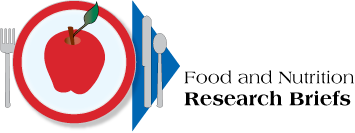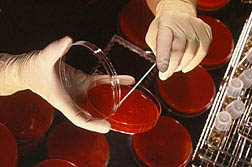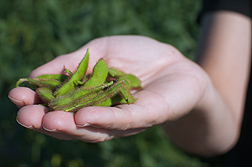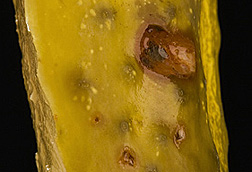| January 2011 |
Adequate Zinc Eases Pneumonia in ElderlyA high proportion of nursing facility residents were found to have low serum (blood) zinc concentrations during an observational study funded by the Agricultural Research Service (ARS) and the National Institute on Aging. However, the scientists found that those with normal blood zinc concentrations were about 50 percent less likely to develop pneumonia than those with low concentrations. Scientific contact: Simin Nikbin Meydani, (617) 556-3129, Nutritional Immunology Laboratory, Jean Mayer USDA Human Nutrition Research Center on Aging at Tufts University, Boston, Mass. |
|
|
|
B Vitamins and the Aging Brain ExaminedB vitamins—B-6, B-12 and folate—all nourish the brain. Agricultural Research Service (ARS) nutritionist Lindsay H. Allen has been collaborating in ongoing research that has taken a closer look at the role these nutrients may play in preventing decline in brain function. The investigations are part of the multi-year Sacramento (Calif.) Area Latino Study on Aging, or "SALSA." An analysis of volunteers' blood samples showed that lower levels of one B vitamin, folate, were associated with symptoms of dementia and poor brain function, also called "cognitive decline," as determined by standard tests of memory and other factors. The impairments were detectable even though less than 1 percent of the volunteers were actually deficient in folate. In women, but not men, low levels of folate were associated with symptoms of depression. Scientific contact: Lindsay Allen, (530) 752-5268, ARS Western Human Nutrition Research Center, Davis, Calif. |
Soy Isoflavones at Moderate Levels Have Little Impact on Bone LossAgricultural Research Service (ARS) physiologist Marta D. Van Loan teamed up with Iowa State University researcher D. Lee Alekel and others for a 3-year investigation to determine whether isoflavones extracted from soy protein would protect postmenopausal volunteers against bone loss. Participants in the study took either a placebo tablet or a tablet containing one of two moderate amounts of the isoflavones: 80 milligrams (mg) or 120 mg. Overall, the isoflavones had no significant positive effect on preventing bone loss. However, the 120-mg treatment showed a modest benefit when evaluated in conjunction with lifestyle factors. Scientific contact: Marta D. Van Loan, (530) 752-4160, Obesity and Metabolism Research Unit, ARS Western Human Nutrition Research Center, Davis, Calif. |
|
|
|
Researchers Study Cinnamon ExtractsA water-soluble extract of cinnamon, which contains antioxidative compounds, could help reduce risk factors associated with diabetes and heart disease, according to findings from Agricultural Research Service (ARS) studies. Volunteers were divided randomly into two groups and given either a placebo or 250 milligrams of a dried water-soluble cinnamon extract twice daily along with their usual diets. Blood was collected after an overnight fast at the beginning of the study, after six weeks, and after 12 weeks to measure the changes in blood glucose and antioxidants. The study demonstrated that the water-soluble cinnamon extract improved a number of antioxidant variables by as much as 13 to 23 percent, and improvement in antioxidant status was correlated with decreases in fasting glucose. Scientific contact: Richard A. Anderson, (301) 504-8091, ext. 277, Diet, Genomics and Immunology Laboratory, ARS Beltsville Human Nutrition Research Center, Beltsville, Md. |
Hyperspectral Imaging Speeds Detection of CampylobacterAgricultural Research Service (ARS) scientists say a type of high-tech imaging can be used to distinguish the foodborne pathogen Campylobacter from other microorganisms as quickly as 24 hours after a sample is placed on solid media in a Petri dish. The scientists used technology called hyperspectral imaging, which combines digital imaging with spectroscopy, to provide hundreds of individual wavelength measurements for each image pixel. This "sensing" technology, which was nearly 100 percent accurate with pure cultures of the microorganisms, could be used for early detection of presumptive Campylobacter colonies in mixed cultures. The researchers are working toward developing a presumptive screening technique to detect Salmonella and Campylobacter in food samples. Scientific contact: Seung-Chul Yoon, (706) 546-3205, Quality and Safety Assessment Research Unit, ARS Richard B. Russell Agricultural Research Center, Athens, Ga. |
|
|
|
Blocking E. coli Bacteria Before They Move InAn Agricultural Research Service (ARS) scientist and his university colleagues have discovered a key gene and chemical interactions that allow Escherichia coli (E. coli) O157:H7 bacteria to colonize the gut of cattle. To proliferate, E. coli express genes differently based on their environment, such as outside the cattle host, inside the cattle rumen, or even at the end of the bovine GI tract. The researchers showed that "quorum sensing" chemicals called acyl-homoserine lactones (AHLs), which are produced by other bacteria, are present within the bovine rumen, but absent in other areas of the cattle GI tract. E. coli harbor a regulator called SdiA, which senses these AHLs and then prompts the E. coli to attach and colonize. Limiting production of the SdiA chemical, or blocking bacterial reception of the AHLs, may eventually lead to new strategies for keeping E. coli from attaching inside the animal. Scientific contact: Thomas S. Edrington, (979) 260-3757, Food and Feed Safety Research Unit, ARS Southern Plains Agricultural Research Center, College Station, Texas. |
New Soybeans Bred for Oil That's More Heart-HealthyProducts made from soy oil stand to benefit from two new germplasm lines conventionally bred by Agricultural Research Service (ARS) scientists and their university colleagues. These new lines produce high levels of oleic acid. The researchers identified and used a mutant pair of alleles, or gene copies, to bolster the beans' oleic-acid production. Typically, soy oil is 13 percent palmitic acid, 4 percent stearic acid, 20 percent oleic acid, 55 percent linoleic acid, and 8 percent linolenic acid. But the new beans contain more than 80 percent oleic acid. Scientific contact: Kristin D. Bilyeu, (573) 884-2234, ARS Plant Genetics Research Unit, Columbia, Mo. |
|
|
|
Kids and Diabetes Risk: Do Chromosomes Hold New Clues?Children who have a high risk of developing type 2 diabetes might be identified earlier by way of tell-tale genetic indicators known as biomarkers. Some of those new biomarkers might be pinpointed in Agricultural Research Service (ARS)-funded research conducting fine-scale mapping of the genes on a region of chromosome 13. This investigation builds upon earlier work, published in 2007 in the Journal of Clinical Endocrinology and Metabolism, in which researchers identified a region that influences fasting blood sugar (glucose) levels. In earlier studies, that chromosomal region was associated with risk of obesity in adults, but had not been aligned with type 2 diabetes risk in youngsters or adults. Scientific contact: Nancy E. Butte, (713) 798-7179, ARS Children's Nutrition Research Center, Houston, Texas. |
Pickle Spoilage Bacteria May Help EnvironmentSpoilage bacteria that can cause red coloration of pickles' skin during fermentation may actually help clean up dyes in textile industry wastewater. Agricultural Research Service (ARS) scientists noted that several Lactobacilli modify azo dyes, which are used in the textile industry and may wind up in wastewater if untreated. These azo dyes impart vivid and warm colors such as red, orange and yellow to fabric. Though many azo dyes are non-toxic, some have been found to be mutagenic. This is the first report that food-related microorganisms can transform azo dyes. Scientific contact: Ilenys Pérez-Díaz, (919) 513-0165, ARS Food Science Research Unit, Raleigh, N.C. |
|










